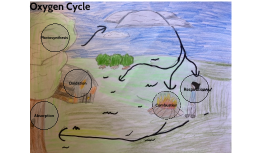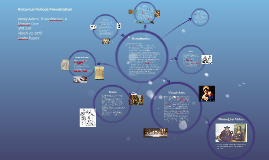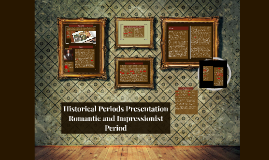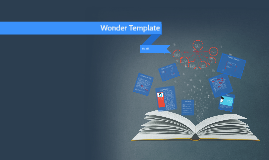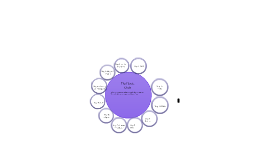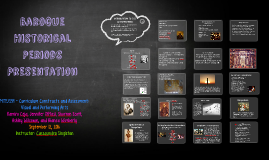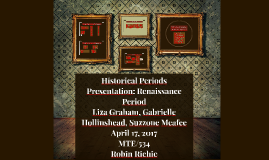Historical Periods Presentation
Transcript: Raphael- The Fire of Borgo Da Vinci- Vitruvian Man Titian- Assunta Michelangelo - The Creation of Adam by Michelangelo, Sistine Chapel ceiling Donatello- Saint Mark Tielman Susato- Danserye (Dance) Dance was for entertainment Considered a social expectation- royal court stewards danced to prove themselves Dancing done in pairs- usually natural component of courtship Most famous collections of instrumental music, called Danserye, was written by composer Tielman Susato in 1551(Taylor, n.d). Music was often performed by harpsichordists, lutenists or instrumental groups (Taylor, n.d). Paired dances were the pavane and the galliard “The pavane was a slow, stately, processional-style dance in two-beat time, while the galliard was brisk, lively dance with skips and jumps in three-beat time” (Taylor, n.d). Mona Lisa Video Renaissance Defining characteristics 14th – 17th century period, began in Italy Bridge between middle ages and modern era Intellectual movement called humanism Term Renaissance means- “rebirth” “The discovery and exploration of new continents, the substitution of the Copernican for the Ptolemaic system of astronomy, the decline of the feudal system and the growth of commerce, and the invention or application of such potentially powerful innovations as paper, printing, the mariner's compass, and gunpowder” (Guisepi, n.d) The period is characterized by a rebirth among English elite of classical learning, a rediscovery of ancient Greek and Roman authors, and a recovery of the ancient Greek spirit of scientific inquiry (British Literature Survey, n.d). English literary accomplishment: a major writer was William Shakespeare Music The style of painting, sculpture and decorative arts identified with the Renaissance emerged in Italy in the late 14th century; it reached its zenith in the late 15th and early 16th centuries, in the work of Italian masters such as Leonardo da Vinci, Michelangelo and Raphael. In addition to its expression of classical Greco-Roman traditions, Renaissance art sought to capture the experience of the individual and the beauty and mystery of the natural world. Leonardo da Vinci, the ultimate "Renaissance man," practiced all the visual arts and studied a wide range of topics, including anatomy, geology, botany, hydraulics and flight. His formidable reputation is based on relatively few completed paintings, including "Mona Lisa," "The Virgin of the Rocks" and "The Last Supper." It was common for artists of this time to paint religious images of subjects such as, The Last Supper, Sistene Chapel, or the The Virgin Mary that at the time were considered devotional objects, but are now considered works of art. The Renaissance was a time of growing knowledge for the poor, the idea of humanism and the idea of free thinking (History, 2012). The idea of Humanism was that humans had the ability to do anything Visual and performing arts provided pivotal inspiration during this time giving people the courage and ability to revive cultural ideals, values, and intellect lost during previous centuries. References British Literature Survey. (n.d). Periods: Renaissance. Retrieved from http://people.umass.edu/eng2/per/renaissance.html Guisepi, R. A. (n.d). The Renaissance. Retrieved from http://history-world.org/renaissance.htm History (1996-2012). Retrieved from http://www.history.com/topics/renaissance-artdance-music-of-the-renaissance-history-and-forms.html Renaissance spell (2007-2011). Retrieved from http://www.renaissance-spell.com/renaissance-architecture.html RENAISSANCE DRAMA . (n.d.). Retrieved from http://www.baruch.cuny.edu/library/alumni/online_exhibits/digital/2000/c_n_c/c_05_renaissance/renaissance_drama.htm Taylor, J. (n.d). Dance Music of the Renaissance: History and Forms. Retrieved from http://study.com/academy/lesson/ The Renaissance. (n.d). Retrieved from http://www.tampapix.com/renaissance.htm http://www.history.com/topics/leonardo-da-vinci/videos/historys-burning-questions-mona-lisa Visual Arts Early Renaissance music (1400 – 1467) gradually dropped the late Medieval period's complex devices of isorhythm and extreme syncopation, resulting in a more flowing style. What the music "lost" in rhythmic complexity, it gained in rhythmic vitality, as a "drive to the cadence" became a prominent feature around mid-century 1470- music starts to be printed using a printing press Famous makers- Neuschel for his trumpets Music was polyphony -is a texture consisting of two or more simultaneous lines of independent melody 1534 until around 1600, an impressive poly-choral style developed, which gave Europe some of the grandest, most sonorous music composed up until that time, with multiple choirs of singers, brass and strings in different spatial locations St. Mark's Basilica which led to the Baroque era. Examples of instruments: Brass, stings, percussions, and woodwinds (get pictures for reference) Classical learning and wisdom after a long period of cultural decline and stagnation (Guisepi,






